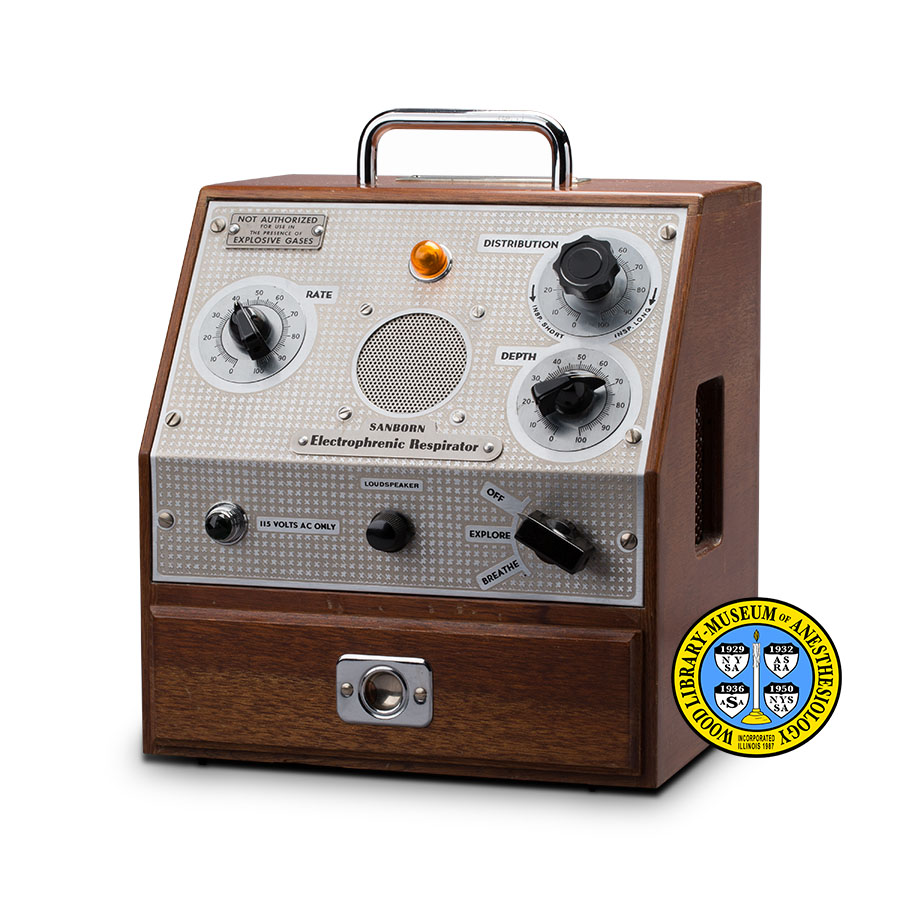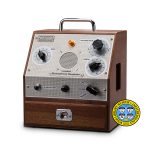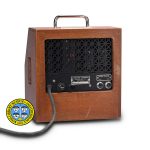Sanborn Electrophrenic Respirator
Anesthesiologists are responsible for maintaining the patient's vital functions during surgery. Electric stimulation of the phrenic nerve for resuscitation was introduced in 1872. This nerve runs from the neck to the diaphragm (the muscle that causes the lungs to expand during breathing). American cardiologist and inventor Stanley J. Sarnoff, M.D. (1918-1990) reintroduced the technique for artificial respiration. From 1948 through 1951, Dr. Sarnoff and his colleagues published numerous articles on electrophrenic respiration.
The original apparatus was described as a "cartload" of equipment. This portable version was made by Sanborn Company, of Cambridge, MA, probably in the 1950s. One contributor to its design was John W. Severinghaus, M.D. (born 1922). He designed a portable apparatus after seeing a demonstration of the technique, and sold one of his devices to Dr. Sarnoff. In 1952, the world-wide poliomyelitis (polio) epidemic reached the United States. This led to the invention of many new ventilators. The technique of radiofrequency-controlled electrophrenic respiration, introduced in the 1960s, is still in limited use.
Catalog Record: Sanborn Electrophrenic Respirator Electrophrenic Respirator
Access Key: apon
Accession No.: 1992-06-25-1 A
Title: Sanborn electrophrenic respirator / Sanborn Company.
Corporate Author: Sanborn Company.
Title variation: Alt Title
Title: Sanborn EPR.
Physical Description: 1 respirator : metals, wood, plastics, rubber, textile ; 31 x 208 x 381 cm.
Subject: Respiration, Artificial – instrumentation.
Subject: Electric Stimulation – instrumentation.
Note Type: General
Notes: Dr. Sarnoff and his associates introduced the technique of electrophrenic respiration in 1948, at which time it has been described has having been large and cumbersome (Severinghaus 2004, p. 193). The first year in the date range is based on the date of the earliest description of the cataloged apparatus. The second year in the date range is the year that the company was acquired by Hewlett Packard.
Note Type: General
Notes: Described from the perspective of the user, the controls being in front and the electrode receptacle on the left side. Described with the skin electrode inserted in the receptacle extended to it full length toward the left, and with the power cord fully extended from the back.
Note Type: General
Notes: CAUTION: the drawer contains two wires that are each tipped with a sharp hook.
Note Type: Citation
Notes: ECG Library webpage. http://www.ecglibrary.com/ecghist.html. Accessed May 12, 2017.
Note Type: Citation
Notes: Fowler G. Stanley J. Sarnoff, 72, cardiologist and inventor [Obituary]. New York Times, May 25, 1990. http://www.nytimes.com/1990/05/25/obituaries/stanley-j-sarnoff-72-cardiologist-and-inventor.html.
Note Type: Citation
Notes: Glenn WWL, Hageman JH, Mauro A, Eisenberg L, Flanigan S, Harvard M. Electrical stimulation of excitable tissue by radio-frequency transmission. Ann Surg. September, 1964;160(3):338-350.
Note Type: Citation
Notes: Saklad M. Inhalation Therapy and Resuscitation. Springfield, Illinois: Charles C. Thomas, 1953:277-282.
Note Type: Citation
Notes: Sanborn Company. Sanborn Electrophrenic Respirator or EPR. Cambridge, Massachusetts: Sanborn Company, December 1949.
Note Type: Citation
Notes: Sanborn Company. Instructions for Operation and Maintenance of Electrophrenic Respirator (EPR). Cambridge, Massachusetts: Sanborn Company, March, 1952.
Note Type: Citation
Notes: Sarnoff SJ, Maloney JV, Whittenberger JL. Electrophrenic respiration. V. Effect on the circulation of electrophrenic respiration and positive pressure breathing during the respiratory paralysis of high spinal anesthesia. Annals of Surgery. November, 1950;132(5):621-929.
Note Type: Citation
Notes: Sarnoff Cardiovascular Research Foundation website: http://www.sarnofffoundation.org/?page=History. Accessed May 10, 2017.
Note Type: Citation
Notes: Severinghaus JW. Anesthesiology. January, 1951;12(1):123-127.
Note Type: Citation
Notes: Severinghaus JW. A rambling and brief autobiography. In: Caton D, McGoldrick KE, eds. Careers in Anesthesiology: Autobiographical Memoirs, Volume 8. Park Ridge, Illinois: Wood Library-Museum of Anesthesiology, 2004:193-195.
Note Type: Citation
Notes: Severinghaus JW. Gadgeteering for health care: The John W. Severinghaus Lecture on Translational Science. Anesthesiology. April, 2009; 110 (4):721.
Note Type: Citation
Notes: Whittenberger JL, Sarnoff SJ, Hardenbergh E. Electrophrenic respiration. II. its use in man. J Clin Invest. January, 1949;28(1):124-128.
Note Type: Physical Description
Notes: One respirator; Built into a wooden cabinet with one drawer; The housing alone measures approximately 31 centimeters in height and approximately 24 centimeters in width; With the drawer closed, the depth of the housing is approximately 21.5 centimeters; With the drawer fully open, the depth of the housing is approximately 34.5 centimeters; The length of the power cord is approximately 358 centimeters;
A metal label plate on the top panel reads: “NOTICE [new line] THE ELECTROPHREINC RESPIRATOR [new line] MUST NOT BE OPERATED BY ANYONE BEFORE THOROUGHLY [new line] READING THE INSTRUCTION BOOK WHICH INDICATES ITS [new line] PROPER USE AND LIMITATIONS”; A metal (chrome?) handle is placed in the top panel, approximately 3 centimeters from the front edge; The front of the apparatus is angled forward from the top edge for a distance of approximately 14 centimeters; The lower portion of the front is upright, and measures approximately 14 centimeters in height;
A textured metal panel covers most of the front of the apparatus; This metal panel occupies the angled portion of the housing and continues downward, to end above the drawer; The angled portion of this panel is occupied by five functional elements; At the upper left is a label plate that reads: “NOT AUTHORIZED [new line] FOR USE IN [new line] THE PRESENCE OF [new line] EXPLOSIVE GAS”; Below this label is a dial marked: “RATE [new line] 0, 10, 20, 30, 40, 50, 60, 70, 80, 90, 100”; The center of this panel is occupied by an electric lightbulb covered by an orange plastic dome, and a metal loudspeaker grill; Below this grill is a label plate that reads: “SANBORN [new line] Electrophrenic Respirator”; The right side of the angled front panel is occupied by two dials; The upper dial is marked “DISTRIBUTION [new line, with downward pointing arrow] INSP. SHORT [new line, with downward
pointing arrow] INSP. LONG [new line] 0, 10, 20, 30, 40, 50, 60, 70, 80, 90, 100”; Below this is a dial marked: “DEPTH [new line] 0, 10, 20, 30, 40, 50, 60, 70, 80, 90, 100”; The upright portion of the metal plate is occupied by three functional elements; On the left is an electric lightbulb covered with a green plastic dome, labeled “115 VOLT AC ONLY”; In the center is a dial marked “LOUDSPEAKER”; On the right is the power switch, marked, from top to bottom, “OFF [new line] EXPLORE [new line] BREATHE”; The left side panel of the wooden housing holds a receptacle labeled “SKIN [new line] OUTLET”; The right side panel has a metal grill; The back panel also has a metal grill, and a metal plate that holds five functional elements; These elements are, from left to right: a power cord, a fuse, a grounding-wire post, and two receptacles labeled “NERVE OUTLET, HIGH” and “LOW”, respectively; There are four rubber feet on the base on the unit;
Several parts were found inside the drawer; These include: the skin electrode (approximately 218 centimeters long, ending with a jack at one end and a blue terrycloth pad at the other), the pen electrode, the fingertip electrode (consisting of a red wire with an electrode at one end and a small vinyl pouch at the other), two gray wires (each ending in a sharp hook), and an inflatable clear vinyl pillow; There is some corrosion on the electrodes.
Note Type: Reproduction
Notes: Photographed by Mr. Steve Donisch, November 14, 2016.
Note Type: Acquisition
Notes: Gift of David Cleasby, M.D.
Note Type: Historical
Notes: Anesthesiologists are responsible for maintaining the patient’s vital functions during surgery. Electric stimulation of the phrenic nerve for purposes of resuscitation was introduced in the 19th Century. This nerve runs from the neck to the diaphragm (the muscle that causes the lungs to expand during breathing). American cardiologist and inventor Stanley J. Sarnoff, M.D. (1918-1990) reintroduced the technique for purposes of sustained respiration. From 1948 through 1951, Dr. Sarnoff and his colleagues published numerous articles on electrophrenic respiration, with far fewer appearing thereafter. This tapering-off coincided with the poliomyelitis (polio) epidemic that reached the United States in 1952, prompting the invention of many new respirators. The technique of radiofrequency-controlled electrophrenic respiration (EPR), introduced in the 1960s, is still in limited use.
Dr. Sarnoff demonstrated the technique at Columbia University in 1947 or 1948. One of the students who attended this demonstration was John W. Severinghaus, M.D. (born 1922). Dr. Severinghaus later described the apparatus used on that occasion as “a cart full of equipment, a Grass stimulator, a motor-driven potentiometer, and an amplifier” (2004, p. 193.) Dr. Severinghaus then decided to create a portable model, which he described in 1951. He built six of these, and sold them to the anesthesia departments at Cornell, Columbia, Harvard and the University of Pennsylvania (where he was later to become a resident), as well as to Dr. Sarnoff himself (2004, p. 195.) The cataloged object is somewhat larger than the respirator designed by Dr. Severinghaus.
Sanborn Company was founded in Boston, Massachusetts in 1917, and made electrocardiographs and other medical apparatus. By 1935, the company had relocated to Cambridge, Massachusetts, where the cataloged object was manufactured. By 1949, the company had produced the portable electrophrenic respirator of which the cataloged object is an example. The product literature states that it was “developed in collaboration with Dr. Sarnoff”. Sanborn Co. was acquired by Hewlett Packard in 1961.
The best known of Dr. Sarnoff’s many inventions is the auto-injector. Examples of this technology are the Epi-Pen (injecting epinephrine to counter a severe allergic reaction), the Lido-Pen (administering the local anesthetic, lidocaine), and the Atro-Pen (administering atropine). In 1981, Dr. Sarnoff endowed a scholarship program that later became the Sarnoff Cardiovascular Research Foundation.
Note Type: Publication
Notes: Abdunur SV, Kim DH. Phrenic nerve stimulation: technology and clinical applications. Neuromodular Frontier. 2016;29:65-75.
Note Type: Publication
Notes: Bach JR. Electrophrenic ventilation: a different perspective. J Am Paraplegia Society. 1991;14(1):9-17.
Note Type: Publication
Notes: Hageman J, Flanigan S, Harvard M, Glen WW. Electromicturition by radiofrequency stimulation. Surg Gynecol Obstet. October, 1966;123(4):807-811.
Note Type: Publication
Notes: Maloney JV, Affeldt JE, Sarnoff SJ, Whittenberger JL. Electrophrenic respiration. IX. Comparison of effects of positive pressure breathing and electrophrenic respiration on the circulation during hemorrhagic shock and barbiturate poisoning. Surg Gynecol Obstet. June, 1951;92(6):672-682.
Note Type: Publication
Notes: Sarnoff SJ, Hardenbergh E, Whittenberger JL. Electrophrenic respiration. Am J Physiol. October, 1948;155(1):1-9.
Note Type: Publication
Notes: Sarnoff SJ, Whittenberger JL, Hardenbergh E. Electrophrenic respiration. III. mechanism of the inhibition of spontaneous respiration. Am J Physiology. November, 1948;155:203-207.
Note Type: Publication
Notes: Whittenberger JL, Sarnoff SJ, Hardenbergh E. Electrophrenic respiration. Science. October 29, 1948;108(2809):482.
Note Type: Exhibition
Notes: Selected for the WLM website.



